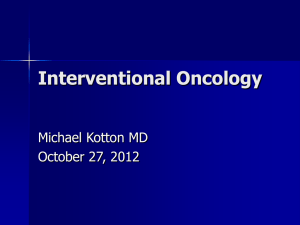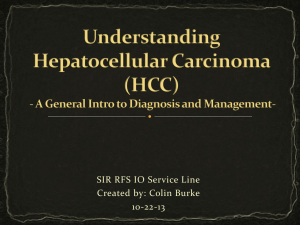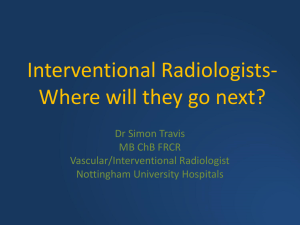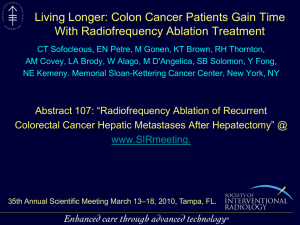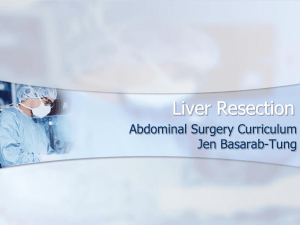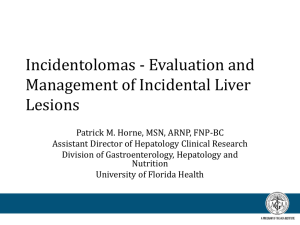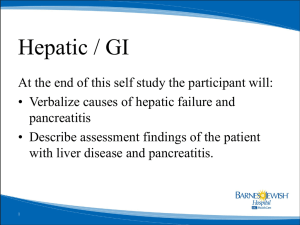Role of Interventional Radiology in a Gastrointestinal
advertisement
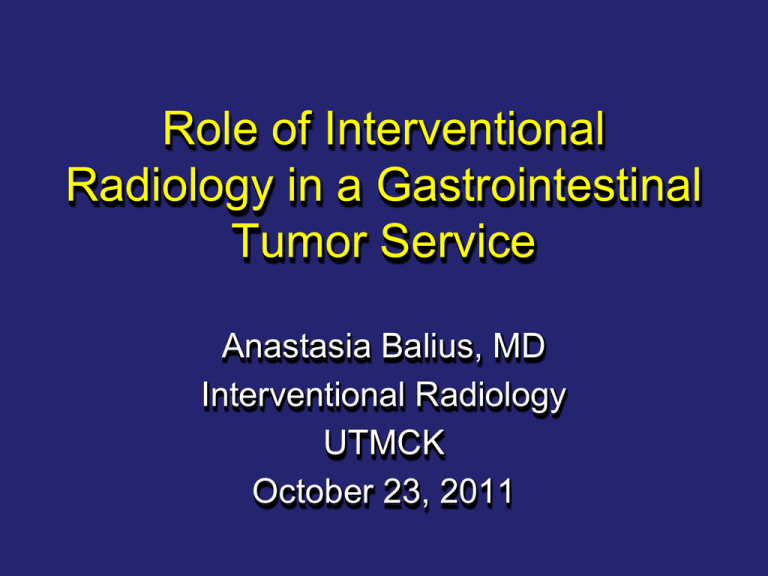
Role of Interventional Radiology in a Gastrointestinal Tumor Service Anastasia Balius, MD Interventional Radiology UTMCK October 23, 2011 Hepatocellular Carcinoma • Approximately 24,120 persons diagnosed with liver or intrahepatic bile duct cancer in the US in 20101 • 18,910 deaths from those cancers during that year1 • Incidence has risen significantly in developed countries in the past two decades2 – Increased prevalence of hepatitis B and C 1American 2Ince . Cancer Society. Statistics last revised 7/7/10 N, Wands JR. The increasing incidence of heaptocellular carcinoma. N Engl J Med 1999;340:798-799. Risk Factors • • • • • • • Same as those for Cirrhosis Hepatitis B/C Inherited errors of metabolism Autoimmune hepatits Non -alcoholic steatohepatitis [NASH] Excessive alcohol intake Environmental exposure to aflatoxin 3 Hepatocellular Carcinoma (HCC) • With definitive treatment 5 year survival is over 50%1 • For all stages combined, 5 year survival is approximately 10%1 • Only 10-15% of patients are candidates for curative therapy2,3 – Surgical resection or transplant 1American Cancer Society. Statistics last revised 8/16/10 JM. Treatment of hepatocellular carcinoma. Curr Treat Options Gastroenterol. 2004;7:431-441 3Kanematsu T, Furui J, Yanaga K, et al. A 16-year experience in performing hepatic resection in 303 patients with hepatocellular carcinoma. J Vasc Interv Radiol 1995; 6:71–74. 2Llovet Metastatic Colorectal Cancer (mCRC) • 5 year survival for stage IV colorectal cancer is 6%1 • Liver is most frequent site of metastases – Approximately 60% of patients with mCRC will eventually have liver as predominant site of disease2 • Surgical resection is treatment of choice – 5 year survival rates after resection >50%3,4 – Feasible in <20% of patients2 1American Cancer Society. Statistics last revised 3/2/2011 AR, Sigurdson ER. Surgical treatment of liver metastases. Semin Oncol. 2002;29:107-118 3Choti MA, et al. Trends in long-term survival following liver resection for hepatic colorectal metastases. Ann Surg. 2002;235:759-766. 4Pawlik TM, et al. Effect of surgical margin status on survival and site of recurrence after hepatic resection for colorectal metastases. Ann Surg. 2005;241:715-722, discussion 722-714. 2Sasson NCCN Categories of evidence • Category 1: The recommendation is based on high-level evidence (eg randomized controlled trials) and there is uniform NCCN consensus • Category 2A: The recommendation is based on lowerlevel evidence and there is uniform NCCN consensus • Category 2B: The recommendation is based on lowerlevel evidence and there is non uniform NCCN consensus (but no major disagreement) • Category 3: The recommendation is based on any level of evidence but reflects major disagreement • All recommendations are Category 2A unless otherwise noted Treatment of HCC HCC confirmed •Multidisciplinary Evaluation •H+P •Hepatitis Panel •Bilirubin, transaminases, alk phos, LDH •PT /INR, albumin, protein, BUN, Cr •CBC, platelets •AFP •Chest imaging •Bone scan as indicated Potentially resectable or transplantable, operable by performace status or comorbidity Metastatic disease Inoperable by performance status or comorbidity, local disease only Unresectable Treatment of HCC For patients with an estimated FLR/total liver volume ratio below recommended values who are otherwise suitable candidates for liver resection, pre-operative portal vein embolization (PVE) should be considered NCCN Practice Guidelines in Oncology – v.2.2011, Hepatobiliary Cancers. Treatment of HCC Clinical presentation Potentially resectable or transplantable Surgical Assessment •Child’s A, B •No portal hypertension •Suitable tumor location •Adequate liver reserve •Suitable liver remnant •UNOS criteria •Patient has a tumor <5 cm in dm or 23 tumors < 3 cm each •No macrovascular involvement •No extrahepatic disease •These patients may be resected if transplantation not feasible Treatment Resection, if feasible (preferred) or locoregional therapy Liver Transplant Child-Pugh Score Clinical/Biochemical Parameters Points for Increasing Abnormality 1 2 3 Encephalopathy (grade) None 1-2 3-4 Ascites None Slight Moderate Albumin (g/dL) >3.5 2.8-3.5 <2.8 Prothrombin time Prolonged (sec) 1-4 4-6 >6 Bilirubin (mg/dL) - for primary biliary cirrhosis 1-2 1-4 2-3 4-10 >3 >10 Class A = 5-6 points; Class B = 7 -9 points; Class C = 10-15 points Treatment of HCC Clinical Presentation Inoperable by performance status or comorbity, local disease only Metastatic disease Treatment Options: Sorafenib (Child-Pugh Class A [Category 1] or B) Clinical Trial Locoregional Therapy RT (conformal or sterotactic) (category 2B) Supportive Care Sorafenib (Child-Pugh Class A [Category 1] or B) Or Supportive Care Or Clinical trial Locoregional Therapy Ablation Embolization • Tumor and margin of • Arterial blood supply to the normal tissue should be tumor must be able to be treated isolated without non-target embolization • Tumors < 3 cm; lesions between 3-5 cm should be • Relatively contraindicated treated in combination with with bilirubin >3 mg/dL embolization • Contraindicated with main PV thrombosis (relative) or Child-Pugh Class C (absolute) Treatment of HCC •Inadequate hepatic reserve •Tumor location Transplant Meets UNOS criteria? Not a transplant candidate Unresectable Extensive liver tumor burden Options: Sorafenib (Child-Pugh Class A [Category 1] or B) Chemotherapy + RT only in the context of a clinical trial Clinical trial Locoregional therapy RT (conformal or sterotactic) (category 2B) Supportive care Systemic or intra-arterial chemotherapy in clinical trial Treatment of mCRC When hepatic disease is not optimally resectable based on insufficient remnant liver volume, approaches utilizing preoperative portal vein embolization1 or staged liver resection can be considered NCCN Practice Guidelines in Oncology – v.3.2011, Colon Cancer 1Covey AM, et al. Combined portal vein embolization and neoadjuvant chemotherapy as a treatment strategy for resectable hepatic colorectal metastases. Ann Surg. 2008 Mar;247(3):451-5. Treatment of mCRC • Ablative techniques may be considered alone or in conjuction with resection. All original sites of disease need to be amenable to ablation or resection. • Some institutions use arterially directed embolic therapy in highly select patients with chemotherapy resistant/refractory disease without obvious systemic disease, with predominent hepatic metastases (category 3) Interventional Radiology’s Role 1. Supportive procedures for the oncology patient 2. Determination of disease 3. Facilitation of definitive surgical treatment 4. Treatment of non-surgical candidates Determination of Disease • AFP and ultrasound are used as screening for HCC • Additional imaging is indicated in the setting of a rising serum AFP or identification of a liver mass nodule on US Determination of Disease • Three different modalities – Triphasic helical CT – Triphasic dynamic contrast enhanced MRI – Contrast enhanced U/S Determination of Disease • Nodules 1 to 2 cm in size need to demonstrate classic arterial enhancement with two different diagnostic techniques • Nodules > 2 cm need demonstrate classic arterial enhancement with only one diagnostic technique • Nodules < 1 cm should be re-evaluated every 3 to 4 months until fit into a size criteria • If nodules are non-diagnostic on imaging, tissue sampling is needed Facilitation of Definitive Surgical Treatment Portal Vein Embolization Transplant “Bridge” Portal Vein Embolization (PVE) • In primary or secondary hepatic malignancy, extended hepatectomies provide a chance of cure1 • Morbidity and mortality of such procedures are considerable2 • Volume and function of the liver remnant is a major risk factor for perioperative complications3,4 1Vauthey JN, et al. Is extended hepatectomy for hepatobiliary malignancy justified? Annals of Surgery. 2004 May; 239(5):72230; discussion 30-2 2Jarnagin WR, et al. Improvement in perioperative outcome after hepatic resection: analysis of 1,803 consecutive cases over the past decade. Annals of Surgery. 2002 Oct;236(4):397-406; discussion-7.. 3Abdalla EK, et al. Extended hepatectomy in patients with hepatobiliary malignancies with and without preoperative portal vein embolization. Arch Surg. 2002 Jun:137(6):675-80; discussion 80-1 4Vauthey JN, et al. Standardized measurement of the future liver remnant prior to extended liver resection: methodology and clinical associations. Surgery. 2000 May;127(5):512-9 Portal Vein Embolization • PVE induces hypertrophy in the nonembolized liver segments • Increase in volume and function of future liver remnant (FLR) • Decreases risk of post-operative hepatic insufficiency Abdalla EK, et al. Portal vein embolization: rationale, technique and future prospects. The British Journal of Surgery. 2001 Feb;88(2):165-75 Makuuchi M, et al. Preoperative portal embolization to increase safety of major hepatectomy for hilar bile duct carcinoma: a preliminary report. Surgery. 1990 May;107(5):521-7 PVE • Normal underlying liver1 – FLR should be 20-25% of total liver volume (TLV) • Chemotherapy induced liver injury2 – FLR should be >30% of TLV • Chronic liver disease (cirrhosis or severe fibrosis)2 – FLR should be >40% 1Abdalla EK, et al. Extended hepatectomy in patients with hepatobiliary malignancies with and without preoperative portal vein embolization. Arch Surg. 2002 Jun;137(6):675-80; discussion 80-1. 2Azoulay D, et al. Percutaneous portal vein embolization increases the feasibility and safety of major liver resection for hepatocellular carcinoma in injured liver. Annals of Surgery. 2000 Nov;232(5):117681. PVE Contraindications • • • • • • • Extrahepatic metastases Overt portal hypertension Tumor invasion of the portal vein Tumor invasion of the FLR Biliary obstruction Renal insufficiency Uncorrectable coagulopathy Couinaud Classificiation Hepatic Anatomy Hepatic Anatomy PVE • Performed under conscious sedation • 2 standard approaches – Percutaneous ipsilateral – Percutaneous contralateral • Wide array of embolic agents – Coils, amplatzer plugs – Particles – Absolute alcohol – Fibrin glue – N-BCA (n-butyl cyanoacrylate) Complications • Migration of embolic material (0.2-5.3%) • Portal vein thrombosis of FLR (<1%) • Portal vein dissection • Intraparenchymal injury • Transient liver failure (3.2%) • • • • • Bleeding (0.2 – 1/6%) Pneumothorax Sepsis Liver abscess (0.3%) Portal hypertension resulting in esophageal variceal hemorrhage Di Stefano DR, et al. Preoperative percutaneous portal vein embolization: evaluation of adverse events in 188 patients. Radiology. 1993 Jul;188(1):73-7 Kodama Y, et al. Complications of percutaneous transhepatic portal vein embolization. J Vasc Interv Radiol. 2002 Dec;13(12):1233-7 Outcomes • Average expected growth of FLR = 8-27%1 • 75% of growth occurs in first 3 weeks postPVE2 • Failure to hypertrophy >5% following PVE is associated with a significantly higher risk of major complications, hepatic insufficiency, and increased 90-day mortality2 1Abulkhir A, et al. Preoperative portal vein embolization for major liver resection: a meta-analysis. Ann Surg. 2008 Jan;247(1):49-57 2Ribero D, et al. Portal vein embolization before major hepatectomy and its effects on regeneration, resectability, and outcome. The British Journal of Surgery. 2007 Nov;94(11): 1386-94 Facilitation of Definitive Surgical Treatment • Locoregional treatment of HCC as a “bridge” to liver transplantation1,2 – Radiofrequency ablation3,4 – Chemoembolization5 – Radioembolization 1Bruix J, Sherman M. Management of hepatocellular carcinoma. Hepatology. 2005;42:1208-1236 JM, et al. Design and endpoints of clinical trials in hepatocellular carcinoma. J Natl Cancer Inst. 2008;100:698-711. 3Pompili M, et al. Percutaneous ablation procedures in cirrhotic patients with hepatocellular carcinoma submitted for liver transplantation: assessment of efficacy at explant analysis and of safety for tumor recurrence. Liver Transpl. 2005;11:11171126. 4Mazzaferro V, et al. Radiofrequency ablation of small hepatocellular carcinoma in cirrhotic patients awaiting liver transplantation: a prospective study. Ann Surg. 2004;240:900-909. 5Richard HM, 3rd, et al. Hepatic arterial complications in liver transplant recipients treated with pretransplantation chemoembolization for hepatocellular carcinoma. Radiology. 2000;214:775-779. 2Llover Treatment of Nonsurgical Candidates • Ablative techniques – Radiofrequency ablation – Microwave ablation – Alcohol ablation • Arterial embolization – Trans-arterial embolization (TAE) – Trans-arterial chemoembolization (TACE) – Trans-arterial radioembolization or Selective Internal Radiation Therapy (SIRT) • Combination therapy Patient Work-up • Laboratory studies – CBC, Chem 7, PT/PTT, liver function tests, tumor markers • Cross-sectional imaging (CT/MRI) • Childs class • Performance status – ECOG/Karnofsky • Staging • Consent with emphasis on palliation and management of expectations Alcohol versus RFA • RFA was shown to be superior to PEI with respect to complete response rate1 • RFA demostrated a lower rate of recurrence2,3 • Overall survival higher for RFA2,3 • Fewer treatment sessions for RFA3 1Brunello F, et al. Radiofrequency ablation versus ethanol injection for early hepatocellular carcinoma: A randomized controlled trial. Scand J Gastroenterol. 2008;43:727-735 2Lin SM, et al. Radiofrequency ablation improves prognosis compared with ethanol injection for hepatocellular carcinoma <4 cm. Gastroenterology. 2004;127:1714-1723 3Shiina S, et al. A randomized controlled trial of radiofrequency ablation with ethanol injection for small hepatocellular carcinoma. Gastroenterology. 2005;129:122-130. RFA vs. Ethanol Injection Survival rate Author Treatment Complete Resonse 2-yr local progression 2 yr 3 yr Lencioni , 20031 PEI (n=50) 82% 38%* 88% NA RFA (n=52) 95% 4%* 96% NA 88% 45% 61% 50% PEI, high dose (n=52) 92% 33% 63% 55% RFA (n=52) 96% 18% 82% 74% PEI (n=114) 100% 11% 82% 63% RFA (n=118) 100% 2% 90% 80% Lin, 20042 PEI, low dose (n=52) Shiina, 20053 1Lencioni P NS <.05 <.05 R, et al. Small hepatocellular carcinoma in cirrhosis: randomized comparison of radiofrequency ablation versus percutaneous ethanol injection. Radiology 2003;228:235-240. SM, et al. Radiofrequency ablation improves prognosis compared with ethanol injection for hepatocellular carcinoma < or = 4 cm. Gastroenterology 2004;127:1714-1723. 3Shiina S, et al. A randomized controlled trial of radiofrequency ablation versus ethanol injection for small hepatocellular carcinoma. Gastroenterology. 2005;129:122-130. 2Lin Local recurrence rates for HCC • More recent study found <3% of patients with single HCC tumor < 2 cm had recurrent disease at 31 months after repeated application of RFA1 1Livraghi T, et al. Sustained complete response and complications rates after radiofrequency ablation of very early hepatocellular carcinoma in cirrhosis: Is resection still the treatment of choice? Hepatology. 2008;47:82-89. 18 Long-Term Survival Survival Rate (%) Author and Year Patient Characteristics Pt # 1 yr 3 yr 5 yr Lencioni, 2005 Child A, 1 HCC <5cm or 3 <3cm 144 100 76 51 Child A, 1 HCC <5 cm 116 100 89 61 Child B, 1 HCC <5 cm or 3 <3 cm 43 89 46 31 Naive patients 319 95 78 54 Non-naïve patients 345 92 62 38 59 94 65 43 Child A, 1 HCC <5cm or 3 <3 cm 359 NA 78 64 Child B, 1 HCC <5cm or 3 <3 cm 160 NA 49 38 Tateishi, 2005 Cabassa, 2006 Choi, 2007 Lencioni R, et al. Early-stage hepatocellular carcinoma in cirrhosis: long-term results of percutaneous image-guided radiofrequency ablation. Radiology 2005;234:961-967 Tateishi R, et al. Percutaneous radiofrequency ablation for hepatocellular carcinoma. Cancer 2005;103:1201-1209 Cabassa P, et al. Radiofrequency ablation of hepatocellular carcinoma: long-term experience with expandable needle electrodes. AJR 2006;185:S316-321 Choi D, et al. Percutaneous radiofrequency ablation for early-stage hepatocellular carcinoma as a first-line treatment: long-term results and prognostic factors in a large singe-institution series. Eur Radiol 2007;17:684-692. Radiofrequency Ablation vs. Resection • RFA compared to liver resection in a prospective randomized controlled study • Patients with solitary HCC <5 cm in dm • No differences in recurrence-free survival or overall survival were found when treatment arms were compared. Chen MS, et al. A prospective randomized trial comparing percutaneous local ablative therapy and partial hepatectomy for small hepatocellular carcinoma. Ann Surg. 2006;243:321-328. Microwave Ablation • In moderately or poorly differentiated HCC, overall survival was significantly better than with PEI1 • In study of 234 pts, 3 yr and 5 yr survival rates were 73% and 57%2 • In the one randomized trial comparing microwave and radiofrequency ablation, no statistically significant differences were observed in the efficacy of the two techniques3 1Seki T, et al. Percutaneous microwave coagulation therapy for patients with small hepatocellular carcinoma: comparison with percutaneous ethanol therapy. Cancer 1999;85:1694-1702 2Dong B, et al. Percutaneous sonographically guided microwave coagulation therapy for hepatocellular carcinoma: results in 234 patients. AJR 2003;180:1547-1541. 3Shibata T, et al. Small hepatocellular carcinoma: comparison of radio-frequency ablation and percutaneous microwave coagulation therapy. Radiology 2002;223:331-337. RFA for mCRC Author Patients Metastases Size (cm) Local contol Survival Solbiati 20011 117 179 0.9-9.6; 61% 3 yr: 46% Gillams 20042 167 354 1-12; mean, 74.9% 3.9 5 yr: 26% Jakobs 20063 68 183 0.5-5.0; mean, 2.2 82% 3 yr: 68% Lencioni 20054 423 543 0.5-5.0; mean 2.7 85.4% 3 yr: 47% 5 yr: 24% Sorensen 20075 102 332 1Solbiati 3 yr: 64% 5 yr: 44% L, et al. Percutaneous radio-frequency ablation of hepatic metastases from colorectal cancer: long-term results in 117 patients. Radiology 2001 Oct;221(1):159-66. 2Gillams AR, Lees WR. Radio-frequency ablation of colorectal metastases in 167 patients. Eur Radiol 2004;14:2261-2267. 3Jakobs TF, et al. Radiofrequency ablation of colorectal liver metastases: mid-term results in 68 patients. Anti-cancer Res 2006;26:671-680. 4Lencioni R, et al. Percutaneous radiofrequency ablation of hepatic colorectal metastases: technique, indications, results and new promises. Invest Radiol 2004;39:689-697. 5Sorensen SM, et al. Radiofrequency ablation of colorectal liver metastases: long-term survival. Acta Radiol 2007;48:253-258. RFA versus resection of mCRC • A number of retrospective studies have compared RFA and liver resection in the tx of liver mets1-3, although RFA has not been well studied in this setting • In retrospective studies comparing RFA and liver resection in liver mets RFA has been inferior to resection with respect to rates of local recurrence and 5-year overall survival4 • Patient selection bias, technological limitations of RFA or both?2 1Hur H, et al. Comparative study of resection and radiofrequency ablation in the treatment of solitary colorectal liver metastases. Amer J Surg. 2009;197:728-736. 2Gleisner AL, et al. Colorectal liver metastases: recurrence and survival following hepatic resection, radiofrequency ablation, and combined resection-radiofrequency ablation. Arch Surg. 2008;143:1204-1212. 3Reuter NP, et al. Radiofrequency ablation vs. resection for hepatic colorectal metastasis: therapeutically equivalent? J Gastrointest Surg. 2009;13:486-91. 4Abdalla EK. Commentary: Radiofrequency ablation for colorectal liver metastases: do not blame the biology when it is the technology. Amer J Surg. 2009;197:737-739. Radiofrequency Ablation • Electrode probes deliver an alternating high-frequency electrical current (460 to 500 kHz) • Ion agitation is converted by friction into heat • Tissue temperature is increased • Cellular death occurs via thermal coagulation necrosis Technique • Re-identify lesion under CT or US • Choose appropriate access site • Plan approach • Place probes • 12 to 16 minute ablation • Tract ablation Considerations • “Heat sink” effects • Compromised sphincter of Oddi – Levaquin and flagyl prep • Adjacent structures – Diaphragm – Abdominal wall – Capsule – Bowel • Size Development of Ablated Region • After 24 to 48 hours, necrotic lesion forms reaching maximum size by 7 days • Ablated lesion may exhibit an increase in size up to 3 months post ablation1 • Ablated tissue will be replaced by scar or reabsorbed • Treated area will not enhance on follow up imaging2 • Most residual viable tumor is evident at 1-3 months after ablation3 1McDougal WS, et al; J Urol 2005; 174:61-63 2Kawamoto, et al; Radiographics 2007; 27:343-355 3Gervais, et al; AJR 2005; 185:64-71 Complications • Hemorrhage1 – Hemoperitoneum – Hemothorax – Hemobilia • • • • Pneumo/Hydrothorax Abscess Sepsis Liver Failure2 • Tumor seeding • Skin Burn • Damage to surrounding structures • Pain in a dermatomal/ diaphragmatic distribution • Post ablation syndrome 1Goto E et al. J Clin Gastroenterol 2009 Oct 3 [Epub ahead of print} 2Kong WT, et al. World J Gastroenterol 2009 Jun 7; 15(21):2651-6 11 Complication Rate • Mortality rate ranges from 0.1% to 0.5% – Most common causes of death were sepsis and hepatic failure • Major complication rate ranges from 2.2% to 3.1% • Minor complication rate ranges from 5% to 8.9% – Most common complications were intraperitoneal bleeding, hepatic abscess, bile duct injury, hepatic decompensation, and grounding pad burns Rhim H. Complications of radiofrequency ablation in hepatocellular carcinoma. Abdom Imaging 2005 Jul-Aug; 30 (4): 409-18 Livraghi T, et al. Treatment of focal liver tumors with percutaneous radiofrequency ablation: complications encountered in a multicenter study. Radiology 2003;26:441-451. De Baere T, et al. Adverse events during radiofrequency treatment of 582 hepatic tumors. AJR 2003;181:695-700. Bleicher RJ, et al. Radiofrequency ablation in 447 complex unresectable liver tumors: lessions learned. Ann Surg Oncol 2003;10:5258. 12 Tumor seeding • Uncommon late complication • Subcapsular location and poor degree of differentiation seem to be at a higher risk1 • Incidence of 0.5% in HCC patients in both a multicenter and single institution series2,3 • Tract ablation used routinely to prevent 1Llovet JM, et al. Barcelona Clinic Liver Cancer (BCLC) Group. Increased risk of tumor seeding after percutaneous radiofrequency ablation for single hepatocellular carcinoma. Hepatology 2001;33:1124-1129. 2Livraghi T, et al. Treatment of focal liver tumors with percutaneous radiofrequency ablation: complications encountered in a multicenter study. Radiology 2003;26:441-451. 3Lencioni R, et al. Early-stage hepatocellular carcinoma in cirrhosis: long-term results of percutaneous imageguided radiofrequency ablation. Radiology 2005;234:961-967. Post RFA Syndrome • Analagous to post embolization syndrome • Defined as low grade fever and flu-like symptoms within the first 24-48 hours lasting approximately one week • Fever usually peaks on day 3 • Flu-like symptoms peak on day 5 14 Post RFA Syndrome • Incidence of 37% in liver ablation • 95% of patients had symptoms but not complete syndrome • Size of treated lesion doesn’t correlate with incidence or severity • Number of ablations (>3) correlates with increased symptoms Wah, et al; Radiology 2005; 237:1097-1102 15 Overall RFA Complication Rates Tissue # patients Complications Mortality rates Liver 2300 [1] 2.2% 0.3% 382 [2] 8% 0.1% Kidney 54 sessions [3] 7% 0% Bone 43 [4] 7% 0% Lung 26 [5] 10% 0% 1. Livraghi T et al. Treatment of Focal Liver Tumors with Percutaneous Radiofrequency Ablation: complications encountered in a multicenter study. Radiology 2003; 226: 441-451 2. Curley S et al. Early and late Complications after Radiofrequency Ablation of malignant Liver Tumors in 608 Patients. Annals of Surgery, Vol 239, No4 April 2004 3. Gervais DA et al, renal Cell Carcinoma: Clinical Experience and Technical Success with Radio-frequency Ablation of 42 tumors. Vascular and Interventional Radiology 4. Goetz et al. Percutaneous image-guided radiofrequency ablation of painful metastases involving bone: a multi center study. J Clin Oncol. 2004 Jan 15;22 (2):300-6 5. Lee et al. Percutaneous Radiofrequency Ablation for inoperable NSC Lung Cancer and matastases: Preliminary report. Radiology, January 2004 Follow-up imaging Post ablation hypoattenuation is greater than original lesion initially, then a decrease in size will be seen HCC • Contrasted CT or MRI in 1 month • CT/MRI every 3 months until one year • Enhancement in HCC pt = residual disease/recurrence 1Akhurst mCRC • Contrasted CT or MRI in 1 month to detect new lesions • CT/MRI every 3 months with tumor markers • PET may be useful in detecting residual tumor or relapse1,2,3 T, et al. Positron emission tomography imaging of colorectal cancer. Semin Oncol 1999;26:577-583 Y, et al. Clinical score for predicting recurrence after hepatic resection for metastatic colorectal cancer: analysis of 1001 consecutive cases. Ann Surg 1999;230:309-321 3Anderson GS, et al. FCG positron emission tomography in the surveillance of hepatic tumors treated with radiofrequency ablation. Clin Nucl Med 2003;28*:192-197 2Fong Intra-arterial therapy HCC • The panel recommends that patients with unresectable/inoperable disease who are eligible to undergo embolization therapy and have tumor lesions > 5 cm should be treated using arterial embolic approaches (chemoembolization, bland embolization, radioembolization) • Those patients with lesions 3-5 cm can be considered for combination therapy with ablation and arterial embolization NCCN Practice Guidelines in Oncology – v.1.2011, Hepatobiliary Cancers Intra-arterial Therapy mCRC • Arterially-directed embolic therapy is considered category 3 • Specifically, highly select patients with chemotherapy resistant/refractory disease, without obvious systemic disease, with predominant hepatic metastases • Radioembolization with yttrium-90 microspheres is the only technique specifically mentioned NCCN Practice Guidelines in Oncology – v.3.2011, Colon Cancer Intra-arterial Therapy Options At this point, institution and physician preference determines technique(s) preferred Catheter is placed via a transfemoral approach with tip within the selected hepatic artery Intra-arterial administration exploits the dual blood supply of the liver • Tumors receive 80100% of their blood supply from hepatic artery • Normal liver receives > 75% of its blood supply from portal vein Breedis C, Young G. The blood supply of neoplasms in the liver. Am J Pathol. 1954;30:969-977. Bland Embolization of HCC • Retrospective analysis • 1-, 2-, and 3-year survival rates of 66%, 46%, and 33% were observed • Survival rates increased to 84%, 66% and 51% when only the subgroup of patients w/o extrahepatic spread or portal vein involvement by tumor was considered1 1Maluccio MA, et al. Transcatheter arterial embolization with only particles for the treatment of unresectable hepatocellular carcinoma. J Vasc Interv Radiol. 2008;19:862-869 Bland Embolization of HCC • Predictors of poor prognosis on multivariate analysis – Tumor size >5 cm – 5 or more tumors – Extrahepatic disease • Portal vein occlusion was not found to be an independent predictor of survival Maluccio MA, et al. Transcatheter arterial embolization with only particles for the treatment of unresectable hepatocellular carcinoma. J Vasc Interv Radiol. 2008;19:862-869 Bland vs. Chemo-embolization of HCC • Only one study directly comparing the two therapies – Pt randomized to TAE, TACE, supportive care • This was stopped early when a demonstrable benefit was shown between chemoembolization and supportive care arms • Due to early termination, lack of power to detect a difference in TACE and TAE Llovet JM, et al. Arterial embolisation or chemoembolisation versus symptomatic treatment in patients with unresectable hepatocellular carcinoma: a randomixed controlled trial. Lancet 2002;359((9319):1734-9. Chemoembolization of HCC Barcelona Multicenter Study1 • 112 patients with unresectable HCC • 85% had hepatitis C • Randomized to blandembolization, chemoembolizaiton, or conservative management • Primary endpoint was survival 1Llovet Hong Kong (Single Center) Study2 • 80 patients with unresectable HCC • 80% had hepatitis B • Randomized to chemoembolization or conservative management • Primary endpoint was survival JM, et al. Arterial embolisation or chemoembolisation versus symptomatic treatment in patients with unresectable hepatocellular carcinoma: a randomixed controlled trial. Lancet 2002;359((9319):1734-9. 2Lo CM, et al. Randomized controlled trial of transarterial lipiodol chemoembolization for unresectable hepatocellular carcinoma. Hepatology 2002;35(5):1164-71 Chemoembolization of HCC Barcelona Study Hong Kong Study • Survival in CE group • Survival in CE group 1 yr = 82% 1 yr = 57% 2 yr = 63% 2 yr = 31% • Survival in bland embolization group • Survival in conservative therapy group 1 yr = 75% 1 yr = 32% 2 yr = 50% 2 yr = 11% • Survival in conservative therapy group 1 yr = 63% 2 yr = 27% Chemoembolization of HCC • In both studies, patients in the chemoembolization group were half as likely to die during the trial than patients in the conservative therapy group – For the Barcelona study: • OR = 0.45 • 95% CI 0.25 – 0.81 – For the Hong Kong study: • OR = 0.5 • 95% CI 0.31 – 0.81 Chemoembolization of HCC • Survival rates in both the CE and control groups were lower in the Hong Kong study than in the Barcelona study – Higher proportion of Okunda stage II disease – Patients with portal vein invasion not excluded Chemoembolization of HCC • Only independent predictor of survival was treatment allocation1 • Benefit of chemoembolization was independent of tumor size, stage or presenting symptom2 – When portal vein invasion present, however, no benefit to chemoembolization seen 1Llovet JM, et al. Arterial embolisation or chemoembolisation versus symptomatic treatment in patients with unresectable hepatocellular carcinoma: a randomixed controlled trial. Lancet 2002;359((9319):1734-9. 2Lo CM, et al. Randomized controlled trial of transarterial lipiodol chemoembolization for unresectable hepatocellular carcinoma. Hepatology 2002;35(5):1164-71 Bland/Chemo-embolization of mCRC Randomized study comparing TAE with TACE demonstrated no advantage of one technique over the other Salman HS, et al. Randomized phase II trial of embolization therapy versus chemoembolization therapy in previously treated patients with colorectal carcinoma metastatic to the liver. Clin Colorectal Cancer 2002;2:173-179. Drug eluting beads in HCC • Objective response rate by imaging (EASL criteria) ranged from 60 to 90%1,2 • Survival rates appear improved over those with conventional TACE3 – 93% at 6 months to 89% at 2 years1,2 • Significantly lower serum levels of chemotherapy drug4 1Kettenbach J, et al. Drug-loaded microspheres for the treatment of liver cancer: review of current results. Cardiovasc Intervent Radiol 2008;31:468476. 2Malagari K, et al. Transarterial chemoembolization of unresectable heptaocellular carcinoma with drug eluting beads: Results of an open-label study of 62 patients. Cardiovasc Intervent Radiol 2008;31:269-280. 3Dhanasekaran R, et al. Comparison of conventional transarterial chemoembolization (TACE) and chemoembolization with doxorubicin drug eluting beads (DEB) for unresectable hepatocelluar carcinoma (HCC) J. Surg. Oncol. 2010; 101:476-480 4Varela M, et al. Chemoembolization of Hepatocellular carcinoma with drug eluting beads: Efficacy and doxorubicin pharmcokinetics. J Hepatol 2007;46:747-787. DEB for mCRC • In study of 55 patients, survival rate of 78% at 18 months1 • Patients thought to have less side effects from the beads than from traditional TACE • Easier to infuse • More study is needed 1Martin RCG, et al. Transarterial chemoembolisation (TACE) using irinotecan-loaded beads for the treatment of unresectable metastases to the liver in patients with colorectal cancer: an interim report. World Journal of Surgical Oncology 2009, 7:80 Chemoembolization Pt Selection • Is patient eligible for hepatic resection? • Is patient eligible for ablation? • Liver dominant disease – Hepatocellular carcinoma – Metastatic colorectal carcinoma – Intrahepatic cholangiocarcinoma – Metastatic neuroendocrine tumors – Rarely, ocular melanoma, sarcoma, pancreas, breast, lung Chemoembolization Work-up • Cross-sectional imaging (MR/CT) • Assessment of performance status (ECOG or Karnofsky) • Childs class • Tumor stage • Laboratory studies (CBC, Chem 7, PT/PTT, liver function tests, tumor markers) Relative Contraindications • Biliary obstruction – High risk of infection of obstructed segments1 • Without intact sphincter of Oddi – Increased risk of abscess2 • Portal vein occlusion – Liver infarction • Elevated bilirubin – Liver failure 11Song SY, et al. Liver abscess after transcatheter oily chemoembolization for hepatic tumors: incidence, predisposing factors and clinical outcome. J Vasc Interv Radiol 2001;12:313-320. 2Kim W, Clark TWI, Baum RA, et al. Risk factors for liver abscess formation after hepatic chemoembolization. J Vasc Interv Radiol 2001; 12:965–968. Relative Contraindications • Biliary obstruction – Percutaneous catheter drainage1 • Without intact sphincter of Oddi – Night before bowel prep and prophylactic antibiotics2 • Portal vein occlusion – Segmental or subsegmental embolization – Limit chemotherapy3 – Document sufficient hepatic collaterol flow4 • Elevated bilirubin – Superselective embolization 1Song SY, et al. Liver abscess after transcatheter oily chemoembolization for hepatic tumors: incidence, predisposing factors and clinical outcome. J Vasc Interv Radiol 2001;12:313-320. 2Geschwind JF, Kaushik S, Ramsey DE, et al. Influence of a new prophylactic antibiotic therapy on the incidence of liver abscesses after chemoembolization treatment of liver tumors. J Vasc Interv Radiol 2002; 13:1163–1166. 3Kiely JM, et al. Chemoembolization in patients at high risk: results and complications. J Vasc Interv Radiol 2006;17:47-53. 4Pentecost MJ, et al. Hepatic chemoembolization: safety with portal vein thrombosis. J Vasc Interv Radiol 1993;4:347-351. Prep for Sphincter of Oddi disfunction • Oral levaquin 500 mg daily two days before and for seven days following the procedure • Oral Flagyl 500 mg twice daily two days before and for seven days following the procedure High risk of acute hepatic failure and post procedural mortality post TACE • >50% of liver volume replaced by tumor • LDH >425 IU/L • AST (SGOT) > 100 IU/L • Bilirubin >2 mg/dL • Individual abnormalities of these four parameters have not been shown to predict adverse outcomes of chemoembolization Charnsangavej, C. Chemoembolization of liver tumors. Semin Invest Radiol 1993;10:150-160. Berger DH, Carrasco CH, Hohn DC, et al. Hepatic artery chemoembolization or embolization for primary and metastatic liver tumors: post-treatment management and complications. J Surg Oncol 1995; 60:116 –121. Brown DB, Fundakowski CE, LiskerMelman M, et al. Comparison of MELD and Child-Pugh scores to predict survival after chemoembolization for hepatocellular carcinoma. J Vasc Interv Radiol 2004; 15:1209 –1218. Side effects • Post embolization syndrome in 80-90% of patients • Pain, fever, nausea, vomitting • Severity varies • PCA and liberal use of antiemetics as well as good pre-procedure medication regimen Leung DA, Goin JE, Sickles C, et al. Determinants of postembolization syndrome after hepatic chemoembolization. J Vasc Interv Radiol 2001; 12:321–326. Complications Serious event = 3-7% Other complications (<1% incidence each) • Hepatic • Renal insufficiency insufficiency/infarction • anemia • Hepatic abscess • Tumor rupture 30 day mortality • Chemical cholecystitis ranges from 1 – 4% • Non-target embolization to the bowel Sakamoto I, et al. Complications associated with transcatheter embolization for hepatic tumors. Radiographics 1998;18:605-619 Gates J, et al. Chemoembolization of hepatic neoplasms: safety, complications and when to worry. Radiographics 1999;19:399414. Major complications Specific Major Complication Reported Rate (%)) Liver failure 2.3 Abscess with functional sphincter of Oddi <1 Post-embolization syndrome requiring extended stay or readmission 4.6 Abscess with biliary-enteric anastamosis/biliary stent/sphincterotomy 25 Surgical cholecystitis <1 Biloma requiring perutaneous drainage <1 Pulmonary arterial oil embolus <1 Gastrointestinal hemorrhage/ulceration <1 Iatrogenic dissection preventing treatemtn <1 Daniel B. Brown, al. Quality Embolization, and Death withinet 30 daysImprovement Guidelines for Transhepatic Arterial Chemoembolization, 1 Chemotherapeutic Infusion for Hepatic Malignancy. J Vasc Interv Radiology July 2009 ;20(7) Supplement:S219S226.e10 Pre-procedure orders • IV normal saline 500 cc bolus then 200cc/hr • Rocephin 1 gm IV • Diphenhydramine 50 mg IV • Dexamethazone 10 mg IV • Ondansetron 24 mg IV • Pepcid 20 mg IV • Dilaudid PCA Post procedure orders • • • • Patient controlled anesthesia Ondansetron 8 mg q8h IV, PRN nausea Tylenol 650 mg q4h po, PRN fever Augmentin 875mg one PO BID x seven days. or if allergic to PCN: Cipro 500mg one PO bid x seven days. Follow up • Labs in three weeks to assess for continued eligibility • Repeat CT or repeat treatment in 4 weeks Discharge • Augmentin or Ciprofloxacin • Fevers < 103o are normal in the first week and do not require cultures Radioembolization or Selective Internal Radiation Therapy (SIRT) This technique selectively targets a very high radiation dose to all tumors (average dose of 280-380 Gy) within the liver, regardless of their cell of origin, number, size or location while at the same time maintaining a low radiation dose to the normal liver tissue (<40 Gy) Radiation in HCC • Traditional radiation therapy in management of unresectable HCC demonstrated palliation of symptoms in >50% of patients and 20% signficant tumor shrinkage • Risk of radiation induced liver toxicity after uniform whole liver radiation to 30 Gy (<dose required to eradicate tumor) delivered over 3 weeks was 5% Sakamoto I, et al. Complications associated with transcatheter embolization for hepatic tumors. Radiographics 1998;18:605-619 Gates J, et al. Chemoembolization of hepatic neoplasms: safety, complications and when to worry. Radiographics 1999;19:399-414. SIR-Sphere size is small enough to gain entry into tumor nodules but too large to pass through the end capillary bed into the venous circulation Tumor vessels 25μm -75μm End arterioles 8 μm SIR-Spheres mean diameter 35 μm Regulatory Status • In US, regulated under the pre-market approval regulations (21 CFR Part 814) – FDA approval March 2002 – Unresectable metastatic liver tumors from primary colorectal cancer together with adjuvant intrahepatic chemotherapy with FUDR • In Europe and UK, Europe and UK regulated under the Active Implantable Medical Device Directive (90/385/EEC) – CE Mark approval October 2002 – Primary and secondary (metastatic) liver cancer Radioembolization in HCC • Partial response rate of 42.2% in phase 2 study of 108 patients with unresectable HCC with/without portal vein thrombosis • More study is needed Kulick LM, et al. Safety and efficacy of 90Y radiotherapy for hepatocellular carcinoma with and without portal vein thrombosis. Hepatology. 2008;47:71-81 Patient Selection Unresectable primary hepatic malignancy: Hepatoma Unresectable metastatic disease: Colorectal Breast Pancreatic Carcinoid Neuroendocrine Cholangiocarcinoma Patient Selection • Tumor board/ multidisciplinary team determination that patient has unresectable liver tumor with a life expectancy > 3 months • ECOG 0,1,2 • Karnofsky score of 60% or higher Patient Work-up 1) CT/MRI/PET imaging to confirm – liver dominant disease + no CNS mets – tumoral/nontumoral volume – patent portal vein 2) Adequate synthetic and excretory liver function – Total bilirubin < 2.0mg/dL – Serum albumin > 3.0g/dL 3) Patient may be on systemic chemotherapy except except Capecitabine, Avastin, Erbitux – Trials in progress to determine safety in conjunction with Capecitabine, Avastin, Erbitux 4) No history of external beam radiation to the liver Patient Work-up • Two absolute contraindications – reflux into arteries that supply the gastroduodenal region • can result in gastritis, pancreatitis, gastric ulceration – exaggerated hepatopulmonary shunting (lung shunt > 20%) • can result in radiation pneumonitis • To address these issues, a pre-treatment diagnostic hepatic angiogram is performed Ability to coil embolize GDA and RGA and others as necessary to prevent reflux into arteries in the gastroduodenal region Pre-treatment hepatic arteriogram Hepatic Arteries Right Gastric Artery Gastroduodenal Artery After coil embolization, injection of 5-6 mCi of Tc-99m labeled MAA as a microsphere surrogate into the hepatic arterial territory to assess extent of hepatopulmonary shunting 19 Reduce implanted activity for lung shunting > 10% Lung shunt fraction Reduce implanted activity by 0 – 10% No reduction required 11 – 15% Reduce by 20% 16 – 20% Reduce by 40% > 20% Do not treat Implanted activity calculation for a whole liver treatment from the proper hepatic artery – 1) Activity (GBq) = BSA*-0.2 + Tumor volume Tumor volume + normal liver volume – 2) Reduce implanted activity for lung shunting as described – 3) Reduce implanted activity for special cases • CRLMs – heavy pre-treatment with systemic chemotherapy • HCC - cirrhosis *BSA = Body Surface Area SIR-Spheres Meds • Rocephin 1gm IV pre procedure. No home antibiotics. • PPI or any H2 blocker one week before and for 4 weeks after. • Medrol dose pack if not diabetic (script written at discharge). • Ketorolac 10mg PO q 4-6 hours PRN pain x 5 days after treatment. • Ondansetron 8mg PO q 8 hours PRN N/V. or Promethazine 25mg tablets, one PO q 6hours PRN N/V. Radiation Safety • Exposure – Bremsstrahlung is typically 15 uSv per Gbq at 15cm from the patient’s right side (initially) • Ward – Outpatient procedure – No pregnant women, children (‘three feet for three days’) – Nursing from left hand side of patient – Shielding unnecessary – No special handling required for blood, body fluids, urine Complications to be aware of… • Postembolization syndrome – may occur in as many as 50% pts; not as severe as that observed with TACE and is usually dominated by fatigue and constitutional symptoms • Gastrointestinal ulceration – incidence minimized with coil embolization of right gastric, etc. • Pancreatitis – incidence minimized with coil embolization of gastro-duodenal artery • Radiation pneumonitis – incidence practically zero with routine work-up and Tc99 lung shunt study • Radiation hepatitis (RILD) – increased risk in patients with cirrhosis and reduced liver reserve • Radiation Cholecystitis – clinically relevant radiation cholecystitis requiring cholecystectomy is not common but does occur Questions? Anastasia Balius, MD Interventional Radiology abalius@mc.utmck.edu 865-242-1496
